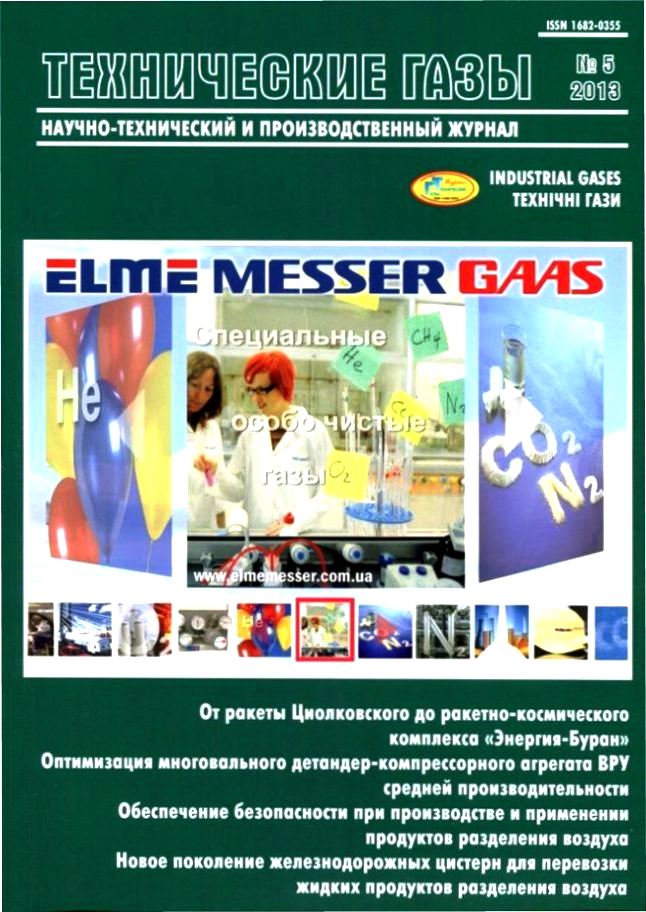THE INFLUENCE OF RECIRCULATION OF THE PERMEATE STREAM ON THE NEON-HELIUM MIXTURE ENRICHMENT PROCESS ON THE POLYMERIC MEMBRANE
DOI:
https://doi.org/10.18198/j.ind.gases.2013.0697Keywords:
Neon-helium mixture, Air separation unit, Polymeric membrane, Permeate, Recycle, Recovery rateAbstract
The use of membranes in the equipment of air separation unit for cleaning the neon- helium mixture from nitrogen presumes to obtain a neon-helium concentrate in the installations with the limited production of liquid cryogenic products. The important indices in such a process are the degree of extraction of the target components (neon and helium) as well as the concentration of nitrogen impurity in the production stream. Alternative calculations of the neon-helium mixture enrichment process on the polymeric membrane in a wide range of operating modes have been presented. The dependence of the extraction degree of the neon-helium mixture on the initial concentration of nitrogen impurity at various recycle ratios has been demonstrated. It was found that recirculation of the permeate stream allowed to approximate the characteristics of the membrane installation to the characteristics of the dephlegmator.
References
Cohen К. (1951). The theory of isotope separation as applied to the large-scale production of U-235. — New-York: McGraw Hill. — 165 p.
Yue-xiao S., Kang X., Peng L. (2012). Characterization of soluble microbial products in 10 large-scale membrane bioreactors for municipal wastewater treatment in China// Journal of Membrane Science. — V. 415. — P. 336-345.
Berezina N., Gnusin N., Dyomina O., Timofeyev S., Dyomina, Timofeyev S. (1994). Hollow fiber membrane degassing in ultrapure water and microbiocontamination// Journal of Membrane Science. — V. 86. — No. 3. — P. 207-229.
Guha K., Majumdar S., Sirkar K. K. (1991). A larger-scale study of gas separation by hollow-fiber-contained liquid membrane permeator// Journal of Membrane Science. —V. 62. — P. 293-307 .
Chuklin A.P., Bondarenko V.L. (2012). Сalculation of the baromembrane processes of rare gases extraction// Tekhnicheskie Gazy. [Industrial Gases]. — No. 6. — P. 26-33. (Rus.).
Bondarenko V. L., Losyakov N. P., Simonenko Yu. M., Chuklin A. P. (2012). Application of membrane processes in the technologies of separation gas mixtures based on air components// Tekhnicheskie Gazy. [Industrial Gases].— № 2. — P. 19-30. (Rus.).
Stern S., Perrin J., Naimon E. (1984). Recycle and multimembrane permeators for gas separations// J. Membr. Sci. — V. 20, — P. 25-43.
Teslik S., Sirkar K.K. (1986). А comparative analysis of the role of recycle or reflux in permeators separating а Ьinary gas mixture// Recent Developments in Separat. Sci. — V. 9. — P. 245-263.
Majumdar S., Heit L.B., Sengupta A., Sirkar К. K. (1987). An experimental investigation of oxygen enrichment in а silicon capillary permeator with permeate recycle// lnd. Eng. Chem. Res. — V. 26. — No. 7. — P. 1434-1441.
Matson S.L., L.J., Quinn J.A. (1983 ). Separation of gases with synthetic membranes// Chem. Eng. Sci.— V. 38. — No. 4. — P. 503-524.
Matson S. L., Lopez J., Quinn J. A. (1983). Separation of gases with synthetic membranes.Review article No. 13// Chem. Eng. Sci. — No. 38. — P. 503-524.
Downloads
Issue
Section
License
LICENSE AGREEMENT
After receiving an article for publication as required revision scientometric databases each author directs the license agreement on the assignment and transfer of the management of copyright. Signatures of the author (s) it is desirable to seal the personnel department of the institution where the author works (authors), or the seal of the Faculty.
Revision refers to the authors one layout for proofreading. Permissible only those fixes that result in compliance with the layout of the original text of the article. Significant changes are not permitted. Layout should be sent to the editorial office within days of receipt.

